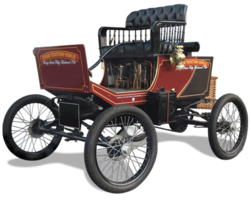I have had two issues over the past year with the Lyka. One day I discovered a puddle under my Lyka that shouldn't have been there. Now this replica of the 1899-1903 Locomobile is prone to dripping water, oil and even some diesel fuel if everything isn't tight, but this puddle was different. Upon further investigation I could see that my tanks were dripping from a few weldments. After discussing with Steam Traction World, they were as perplexed and me. I use well water and my only thoughts are that these tanks do not like my water. I also discovered that the pipe threads had deteriorated too. My only solution was to clean the tanks as best as I could and seal the tanks with POR 15 fuel tank sealer. I also had to use thread inserts to fix the pipe threads. Below are a few pictures showing the issue. Everything is all back together with no leaking.
My Second issue just happened this week. I was preparing the Lyka for our annual Town's Christmas Parade. Steamed her up, drove her around a bit, then loaded her onto my trailer to transport to the parade a couple of days earlier for the parade. I have a place to store the Lyka close to the parade. The Lyka ran just fine going up on the trailer, however when I arrived where I was going to store the Lyka, she began to buck just a bit and run rough. I had a feeling that the timing somehow was a little off. I loaded the Lyka back up and took her back to my shop. Did a re-timing and still she was bucking a bit. I jacked up one wheel and ran the engine trying to listen and see if anything to explain the rough running. Then all of a sudden, the engine smoothed out - that was odd I thought, until I realized the Lyka was spilling water out the back. I burst the copper tubing that goes from the hand pump to the feed pump.


























































